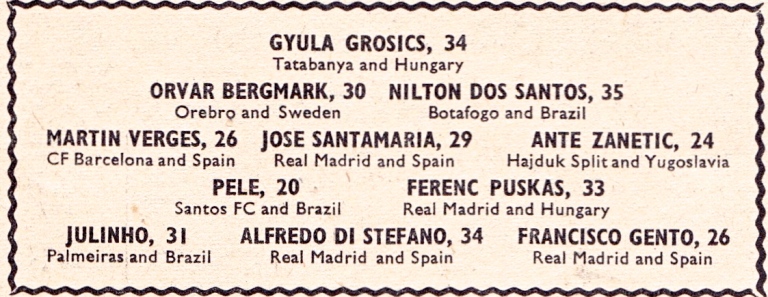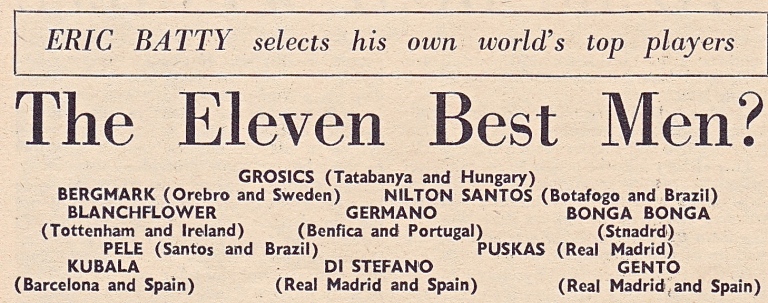 A little while ago we took an affectionate look back here at the quirky football writer Eric Batty and the ever-fascinating World XI selections he published in World Soccer magazine between 1960 and 1992. In this post we’ll take a more detailed look at the players who rocked his stern world sufficiently in the 1960s to earn the ultimate accolade of “by appointment to Eric Batty.”
A little while ago we took an affectionate look back here at the quirky football writer Eric Batty and the ever-fascinating World XI selections he published in World Soccer magazine between 1960 and 1992. In this post we’ll take a more detailed look at the players who rocked his stern world sufficiently in the 1960s to earn the ultimate accolade of “by appointment to Eric Batty.”
 Eric’s first-ever World XI was a real veterans team featuring seven players over the age of 30 and an average age higher than any subsequent selection. There’s no argument with the selection of Puskas and Di Stefano in this, or a number of the years that followed, however some players like Hungarian keeper, Grosics, and full-backs, Bergmark and Nilton Santos, were past their best and their nomination perhaps reflected more their outstanding contributions to the game than their form at the time.
Eric’s first-ever World XI was a real veterans team featuring seven players over the age of 30 and an average age higher than any subsequent selection. There’s no argument with the selection of Puskas and Di Stefano in this, or a number of the years that followed, however some players like Hungarian keeper, Grosics, and full-backs, Bergmark and Nilton Santos, were past their best and their nomination perhaps reflected more their outstanding contributions to the game than their form at the time.

Five-time European Champions Real Madrid unsurprisingly dominate the team with defender Jose Santamaria and winger Paco Gento taking the Spanish team’s quota here to four. Pelé is there of course and he would be a fixture for the first half of the decade along with Puskas, Di Stefano and Gento. What an era it was for right-wingers though. The Brazilian Julinho gets the nod in Eric’s 1960 team ahead of the stiffest of competition from players like Garrincha, Raymond Kopa, Kurt Hamrin and Helmut Rahn.

In 1961 Eric selected the sole African player to ever make one of his selections. The Congolese wing-half Paul Bonga Bonga was little known in England, but he was a big star in Belgium where his pace, energy and fine skills made him the motor of a strong Standard Liege team. Danny Blanchflower became the first player from Britain & Ireland to be selected and Eric’s annual rotation through the world-class wingers available to him saw Ladislav Kubala at outside-right this year.

The 1962 team draws heavily from that year’s World Cup and unsurprisingly features four Brazilians in Djalma Santos, Zito, Pelé and Garrincha. The Yugoslav Fahrudin Jusufi is an interesting selection at left-back and he would become the first player to feature representing two different clubs in two different positions – here it’s Partizan Belgrade and later in the decade it was with Eintracht Frankfurt as a right back.

Jim Baxter is the first Scotsman to be selected in 1963 and there would not be many others following in his footsteps. The Real Madrid trio of Puskas, Di Stefano and Gento still dominate the line-up, but now the World XI’s character is gradually starting to evolve. Milan’s Cesare Maldini and Inter’s Luis Suarez are selected for the first time as the Italian teams began their dominance of the European Cup. Raymond Kopa becomes the fourth world-class right-winger picked in four different years.

Eric Batty didn’t like Helenio Herrera’s defensive mentality, but he at least admired some of the players executing the system. Giacinto Facchetti would be one of the World XI’s most regularly selected players and he makes his first appearance in 1964, alongside teammate Tarcisio Burgnich. Batty generally bemoaned the shift towards backs like Burgnich who were purely destructive in approach however. Luis Suarez is the third Inter player in the team, although he gets shifted to the left wing with Gento out of sorts. There really were many more good right-wingers than left-wingers in the 1960s. Lev Yashin in goal and the Czechs, Jan Popluhar in central defence and Josef Masopust at wing-half, ensured a healthy Eastern European contingent – a regular theme in Eric’s teams over the decades.

By 1965 Benfica were a little past their peak but still contributed five World XI players to this year’s team, a record for a club in a single year. Costa Pereira gets the nod between the posts, Mario Coluna and Germano in defensive positions and Jose Augusto in that ever competitive right-wing spot. Eusebio is selected, oddly, for the first and only time. It’s the first all Latin team too with only players from Brazil, Spain, Portugal and Italy chosen.

The old guard is swept away fully by 1966 and even Pelé makes what will be his last ever World XI line-up. A new generation of Eastern European players come into contention this year – the Hungarians, Bene and Farkas, joining Shalamanov and Yakimov of Bulgaria. Lev Yashin is picked again in goal meaning nearly half of the team is from eastern Europe. Franz Beckenbauer makes his debut and will be a fixture for 11 successive World XIs – easily the most frequently picked player in the feature’s history.

Geoff Hurst becomes England’s first ever nominated player in 1967 at centre forward. With six players from Russia, Bulgaria, Czechoslovakia and Hungary, it’s still a team with a strong eastern European flavour, although regular Inter stalwarts like Facchetti and Mazzola remain.

England’s elevated status in the world game is fully recognised in 1968 with the West Ham trio of Moore, Peters and Hurst all making that year’s selection. Oddly, Hurst is played deeper to allow Sandro Mazzola to play at centre-forward – a reversal of both player’s most commonly recognised positions. The gradual rise of Polish football is reflected in the inclusion on the left wing of Wlodzimierz Lubański. The 1968 team is an all-European affair.

Eric’s last selection of the decade is a curious affair in the attacking half. There are three similarly styled centre forwards in Hurst, Gerd Muller and Lubański and behind them at inside forward are two natural wingers in Ferenc Bene and Dragan Džajić. The rising West German influence as we approach the new decade is evident with Karl-Heinz Schnellinger joining Beckenbauer and Müller in the line-up.



As a childhood friend of “Eric Batty”.I have fond memories of him when we lived on the “Downham “estate,SE London.We payed many street games,common in those days.A different era,go with God,Eric.Derek Durrant.South Australia.